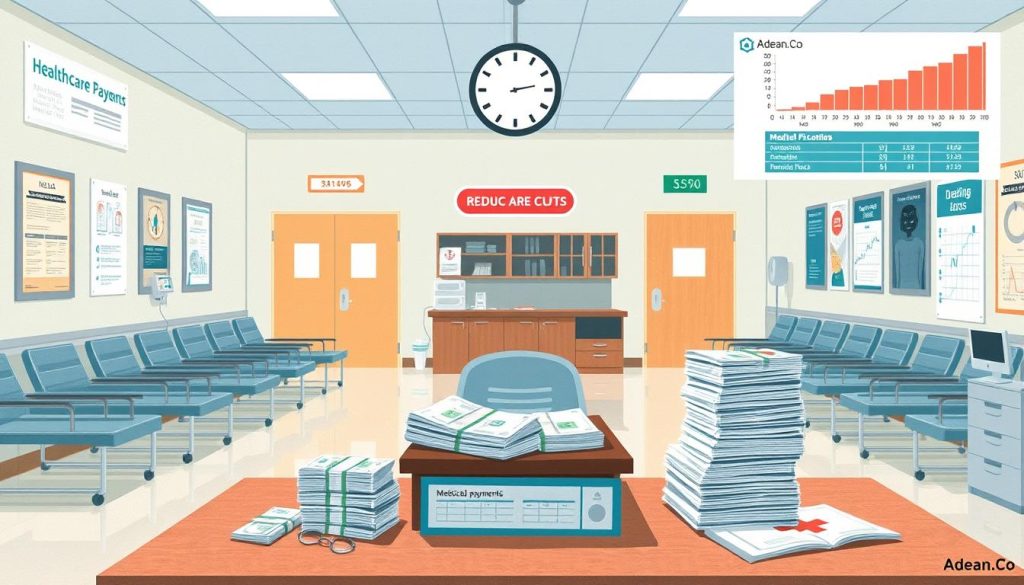Medical Billing Changes with 2025. Medicare Payment Reduction is implementing major payment cuts that will directly impact your billing, revenue, and overall financial health. Understanding the reasons for these reductions, their timing, and their scope will help your practice adapt and thrive in the evolving healthcare landscape.

Key Takeaways
- Medical Billing Changes with 2025 Medicare Payment Reductions will significantly affect healthcare providers’ revenue and medical billing practices.
- These changes stem from cost containment measures, shifts toward value-based care, and updates to Medicare policies.
- The timeline for these adjustments spans several years, requiring careful strategic planning.
- Payment changes will differ across medical specialties, making it essential for providers to fully understand the updates.
- Proactive measures, including adopting new technologies and optimizing operations, will be critical to navigating these changes.
Medical Billing Changes with 2025 Medicare Payment Reductions Overview
The healthcare world is getting ready for big changes in Medicare payments starting in 2025. These changes, caused by different factors, will greatly affect providers, billing, and healthcare delivery.
Key Factors Driving Medicare Reductions
Several key factors are leading to the Medicare payment cuts. These include:
- Efforts to control healthcare costs and improve value-based care
- Adjustments to the Medicare conversion factor
- Changes to the Medicare Physician Fee Schedule
- Reductions in Medicare spending growth targets
Timeline of Implementation
The 2025 Medicare payment changes will roll out over several years. Healthcare providers and billing pros need to keep up and adjust their work.
Scope of Payment Adjustments
The payment adjustments will affect many healthcare services and providers. They will change how much providers get paid, coding rules, and what documents are needed. Healthcare groups must carefully think about these changes and find ways to handle them.
As the healthcare world deals with these big Medicare payment cuts, it’s key for providers and billing pros to stay updated. They need to adjust their work and find new ways to keep giving top-notch care.
Understanding the Medicare Physician Fee Schedule Updates
The Centers for Medicare & Medicaid Services (CMS) make big changes to the Medicare Physician Fee Schedule (MPFS) for 2025. These changes affect how doctors get paid, how much Medicare spends, and the trust fund’s future.
The MPFS sets how much CMS pays for doctor visits and other services under Medicare Part B. The updates aim to keep care quality high and the program financially sound.
| Key Factors Driving Medicare Reductions | Timeline of Implementation | Scope of Payment Adjustments |
|---|---|---|
| Efforts to control rising Medicare costs Adjustments to account for changes in medical practice expenses Reductions in payments for certain services deemed less essential | Initial announcement of changes in 2024 Gradual implementation of updates throughout 2025 Ongoing monitoring and potential refinements in subsequent years | Across-the-board adjustments to conversion factors Targeted reductions for specific medical services Adjustments to account for changes in practice expenses |
It’s key for doctors and billing pros to get these Medicare Physician Fee Schedule updates. They need to follow the rules, get paid right, and keep their practices afloat.
“The changes to the Medicare Physician Fee Schedule are designed to promote the long-term sustainability of the Medicare program while ensuring access to high-quality care for beneficiaries.”
Healthcare providers can tackle medicare spending issues by keeping up with cms rules. They can adjust their billing to serve medicare trust fund patients well.
Credits: American Medical Association
Impact on Healthcare Providers and Medical Billing Practices
Healthcare providers and their billing practices will face big challenges with the 2025 Medicare payment cuts. They need to plan carefully to keep their private practices running. This includes managing finances, handling paperwork, and staffing.
Financial Implications for Private Practices
The cut in Medicare payments will hit healthcare costs for Medicare providers and their Medicare patients hard. Private practices must look at their money coming in and find ways to save. They might talk to insurance companies, cut costs, or find new ways to make money.
Administrative Burden Changes
The new Medicare payment rules will make things harder for providers. They’ll have to deal with more paperwork, coding rules, and rules to follow. Using technology and making processes smoother can help with this.
Staffing and Resource Considerations
Healthcare providers might need to change how they staff and use resources because of the Medicare economic index (MEI) changes. They might need to change their team, train staff, or hire new people. Planning well is key to keep giving good care to patients.
“The 2025 Medicare payment reductions will undoubtedly test the resilience and adaptability of healthcare providers. Those who proactively address the financial, administrative, and staffing challenges will be better positioned to navigate this transition and continue serving their Medicare patients.”
Medicare changes with 2025 Conversion Factor Modifications
The healthcare world is facing big changes with the 2025 Medicare payment cuts. A key area to watch is the Medicare Conversion Factor. This number affects how much doctors get paid, which impacts patient care and healthcare advocacy.
The Medicare Conversion Factor is a number that helps figure out payments for covered services. With the cuts coming, this number will change a lot. This change will be a big challenge for doctors and their billing teams.
| Year | Medicare Conversion Factor | Percentage Change |
|---|---|---|
| 2024 | $33.89 | -1.66% |
| 2025 | $32.41 | -4.37% |
The Medicare Conversion Factor is set to drop, affecting doctor payments. This could put a squeeze on private practices. It might also make it harder for patients to get the care they need, highlighting the need for healthcare advocacy.
As these changes come, doctors, billing experts, and patient advocates must work together. They need to make sure quality care and fair payments keep flowing to Medicare patients.

“The upcoming modifications to the Medicare Conversion Factor will undoubtedly reshape the healthcare landscape, requiring a concerted effort to protect patient access and advocate for fair reimbursement policies.”
Changes in Medical Billing Documentation Requirements
The healthcare industry is facing big changes with the 2025 Medicare payment cuts. Medical billing practices are changing a lot. Providers and billing pros need to learn new coding rules, updates, and best ways to bill to get paid right and avoid fines.
New Coding Guidelines
Healthcare providers must learn new coding rules. This includes updates to ICD-10-CM and CPT codes, and new modifiers. Keeping up with these changes is key for correct medical billing and successful claims.
Compliance Updates
Providers also need to know about new compliance rules. This includes changes to how documents are kept, audits, and medicare payment impact reports. Following these rules closely is vital for rural healthcare providers and all others to stay financially stable.
Documentation Best Practices
- Keep detailed patient records with full clinical notes, accurate codes, and procedure details.
- Update your practice’s documentation policies to meet the latest medicare reform needs.
- Train your staff well on the new documentation and coding rules.
- Use technology to make the billing and documentation process easier.
By staying informed and proactive, healthcare providers can handle the changing medical billing world. This helps them keep their practices financially strong despite Medicare payment cuts.
Technology Integration for Medicare Payment Processing
The healthcare industry is facing big changes in Medicare payments. Technology integration is key for medical billing companies and healthcare providers. They use advanced tools and platforms to manage finances better and process Medicare claims faster. This helps them deal with the expected medicare fee reductions.
Telemedicine for healthcare providers is also important. It makes care more accessible and billing more efficient. By linking telemedicine with billing systems, healthcare groups can send Medicare claims on time. This protects their medical practice finances.
Technology in medical billing companies has changed how practices handle money. Tools for coding, submitting claims, and handling denials make work easier. These systems also give valuable data and insights. This helps practices make smart choices and keep up with Medicare changes.
| Technology Integration Benefits | Impact on Medicare Payment Processing |
|---|---|
| Telemedicine integration | Improved clinical documentation and timely claim submission |
| Automated billing and coding systems | Reduced administrative burden and increased accuracy |
| Data analytics and reporting tools | Informed decision-making and adaptability to policy changes |
By using technology, medical billing companies and healthcare providers can handle Medicare changes well. They can keep their practices financially stable and growing for the long term.

Rural Healthcare Provider Considerations
The healthcare industry is getting ready for big changes in 2025. Rural healthcare providers are facing big challenges. They are key to making sure everyone gets quality care, especially in places with few resources and hard-to-reach areas.
Special Provisions for Rural Areas
The Centers for Medicare & Medicaid Services (CMS) knows how important rural healthcare is. They’ve made special rules to help these providers. These include:
- Higher payment rates for services in rural areas
- Breaks from some quality reporting to ease the workload
- More money for telehealth and healthcare technology integration to reach more people
Access to Care Challenges
Even with these efforts, rural healthcare providers still have big problems. They struggle with limited funding, not enough staff, and being far from other places. Advocacy for Medicare changes and new healthcare technology integration ideas are key. They help make sure rural areas get the healthcare they need.
| Challenges Faced by Rural Healthcare Providers | Potential Solutions |
|---|---|
| Funding Constraints | More money for rural providers, grants, and financial help |
| Staffing Shortages | Programs to keep staff, telemedicine, and training for more workers |
| Geographic Isolation | More telehealth, mobile clinics, and working with local groups |
By focusing on the needs of rural healthcare providers, we can make sure everyone gets the care they need. This is true no matter where they live.
Strategies for Adapting to Medicare Payment Reductions
Healthcare providers are facing big changes in 2025 with Medicare payment cuts. It’s important to find ways to deal with these changes. One good strategy is to keep a close eye on your money and look for ways to save.
Using new technology in healthcare can also help. Getting better billing systems can make your work easier and more accurate. It also helps you follow new rules better. Plus, using telemedicine can help you reach more patients and make up for lost money.
It’s also key to speak up about Medicare payment changes. Joining groups, going to conferences, and talking to lawmakers can make a difference. This way, you can help shape how healthcare is paid for and make sure your voice is heard.
FAQ
What are the key factors driving the 2025 Medicare payment reductions?
The main reasons for the 2025 Medicare payment cuts are to control costs and keep Medicare solvent. Rising healthcare costs, demographic shifts, and the COVID-19 pandemic have all played a role. The Centers for Medicare & Medicaid Services (CMS) made these changes to manage these factors.
When will the 2025 Medicare payment reductions be implemented?
The Medicare payment cuts will start in 2025, with the first changes on January 1. CMS has a detailed plan to roll out these changes. This will give healthcare providers time to adjust their billing practices.
What is the scope of the 2025 Medicare payment reductions?
Many healthcare services and providers will see changes in 2025. The cuts will affect the Medicare Physician Fee Schedule, impacting various services and visits. The size of the cuts will vary by service and provider type.
How will the 2025 Medicare payment reductions affect the Medicare Physician Fee Schedule?
The cuts will significantly alter the Medicare Physician Fee Schedule. CMS will adjust the Medicare Conversion Factor, affecting how much providers get paid. These changes will directly impact the reimbursement for services to Medicare patients.
What are the financial implications of the 2025 Medicare payment reductions for private medical practices?
Private medical practices face big financial challenges with these cuts. Practices that rely on Medicare may struggle to keep up revenue and profits. Providers need to find ways to save costs and diversify their income to deal with these changes.
How will the 2025 Medicare payment reductions affect the administrative burden for healthcare providers?
The cuts will increase the administrative work for providers. They will need to spend more time on billing and coding changes. This extra work might force them to rethink their staffing and resources.
What impact will the 2025 Medicare payment reductions have on patient access to care?
These cuts could limit patient access, especially in rural or underserved areas. Providers may have to choose which services to offer or patients to see. Ensuring access to care for Medicare patients will require effort from providers, policymakers, and advocacy groups.
How can healthcare providers adapt to the 2025 Medicare payment reductions?
Providers can adapt by using various strategies. They can improve billing, use technology, diversify patients, and advocate for changes. Early planning and adaptation are key to success in the new Medicare payment landscape.



